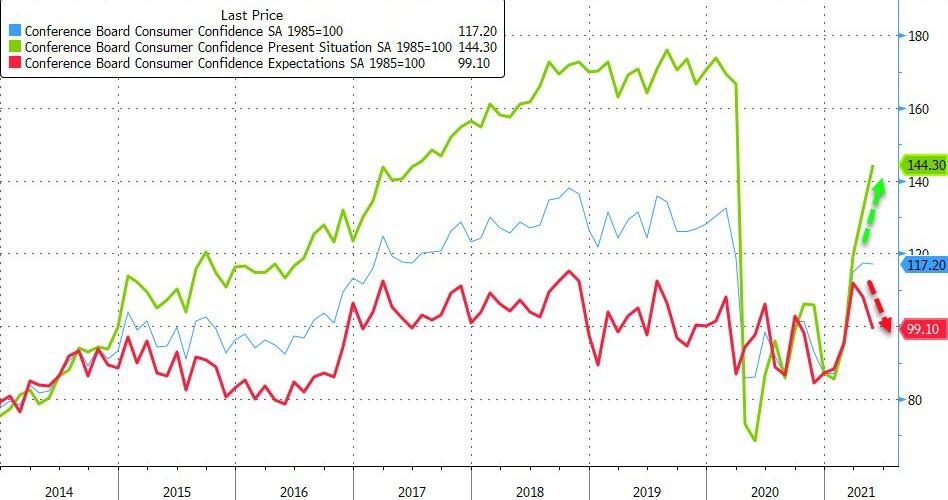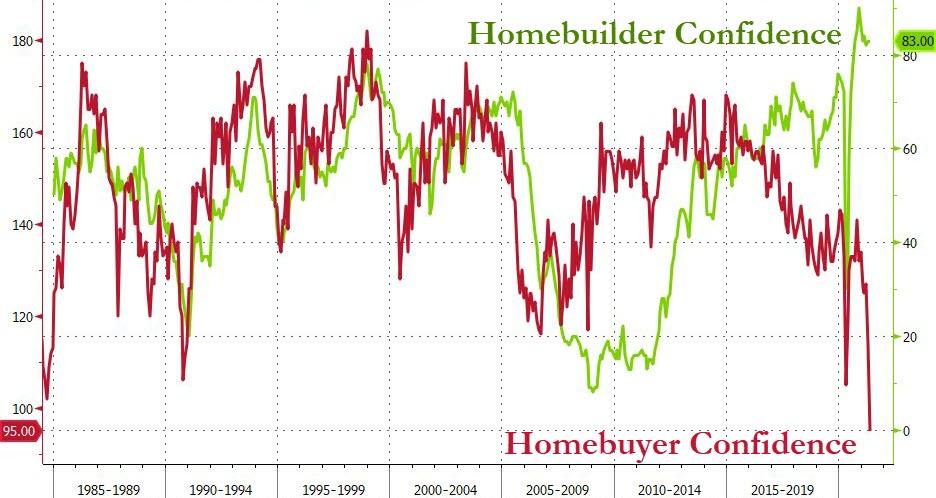Stocks fell slightly this morning as bulls ran out of steam. Before the market opened, Fed officials initially sent futures higher by talking down inflation worries. Lael Brainard, Raphael Bostic, and James Bullard all explained that “bottlenecks” and supply shortages could push prices higher in the coming months, but any increases would simply be temporary.
Or, as Fed Chairman Jerome Powell loves to say, “transitory.”
Moreover, those same officials said that the Fed’s dovish monetary policy would continue.
By noon, however, investor enthusiasm waned in the face of concerning new reports. The most recent being the Conference Board’s May Consumer Confidence Index, which was revised from 117.5 to 117.2, well below the consensus estimate of 118.8.

But perhaps the most disappointing reading was found in expected consumer confidence (in red), which sunk dramatically to 99.10.
“Consumers’ assessment of present-day conditions improved, suggesting economic growth remains robust” in Q2 said Lynn Franco, senior director of economic indicators at the Conference Board.
“However, consumers’ short-term optimism retreated, prompted by expectations of decelerating growth and softening labor market conditions in the months ahead.”
And as if things couldn’t get any worse, homebuilders also learned today that new US home sales fell 5.9% month-over-month in April. It’s an absolute “gut punch” that comes after a major March revision in new homes sales growth from +20.7% to just +7.4% month-over-month.
Meanwhile, home prices continue to surge at their fastest pace since 2005. The combination of factors has led to a complete collapse in homebuyer confidence, opposite sky-high confidence on the builder side.

Don’t worry, though, the coming storm of inflation is merely “transitory” according to the Fed. But what about a period of “stagflation,” where demand stagnates while inflation soars?
Will that be a short-term hurdle, too? Or will it become a bigger problem over time?
These are questions that aren’t being answered truthfully by central banks. And unless Powell clarifies his position on rates soon, more uncertainty lies ahead for traders as new conflicting economic data emerges.
“The market is basically in a holding pattern until the next big event, which is the Fed’s tapering schedule (or not tapering schedule),” wrote Tom Essaye, founder of Sevens Report, in a note.
“Until we have more clarity on Fed tapering and the longer-term outlook for inflation, we should expect this type of incremental volatility.”
Leuthold Group chief investment strategist Jim Paulsen also noted that inflation is driving sentiment, (and growth stocks in particular) as rates dominate the market’s narrative.
“[Monday’s rally] was driven by inflation anxiety relief,” Paulsen said.
“Evidence that inflation fears were calming in the bond and commodity markets began to drive the stock market late last week and has continued into today. Growth stocks including technology have regained leadership as yield and inflation fears ease.”
This was before tech stocks gave up their morning gains. Now, they’re looking far less in control than when the market opened.
And this flip-flopping will persist until investors get either the “green light” from the Fed (via additional rate squashing) or a “red light” in the form of taper talks. But even then, it remains to be seen if investors believe what the Fed has to say.
So, with stocks stalling beneath the all-time highs once again, be wary of rapid dips. The market has shown a propensity for them in recent weeks.
And they’re unlikely to stop any time soon as traders digest a myriad of signals.








